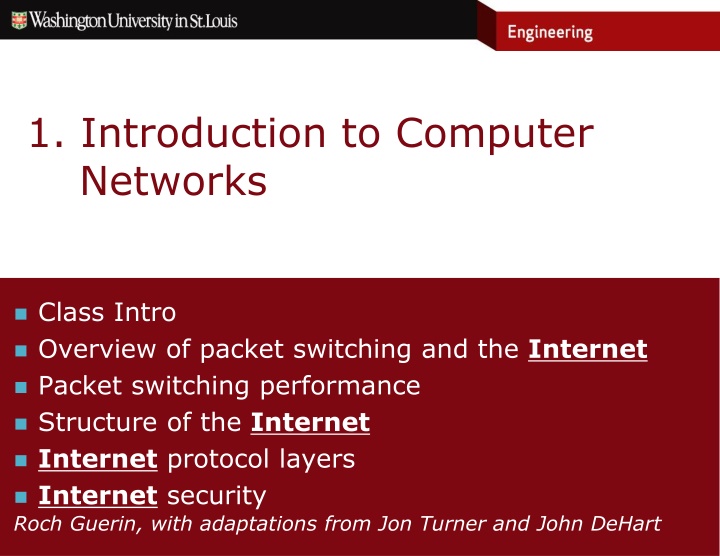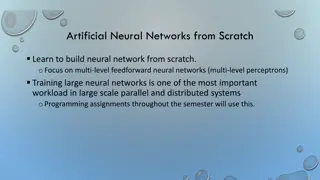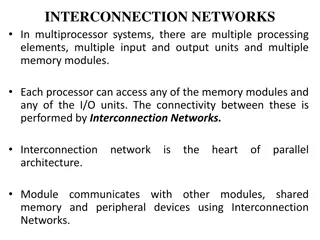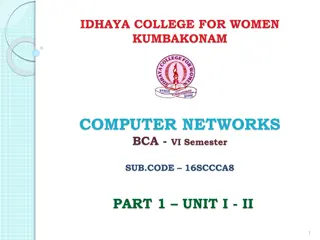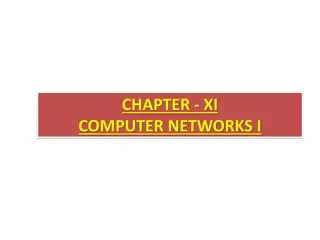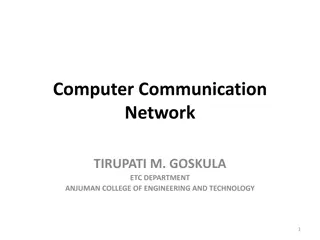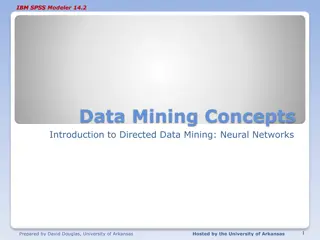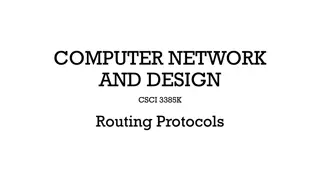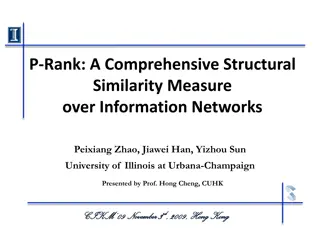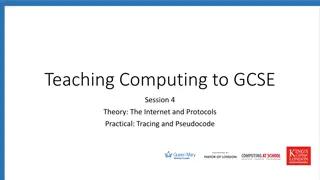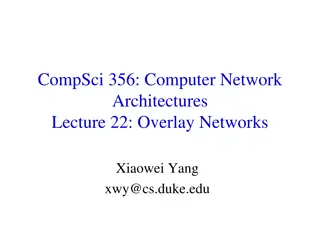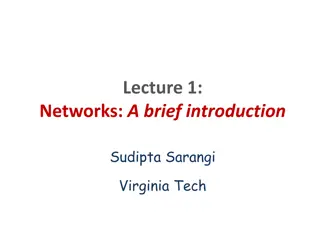1. Introduction to Computer Networks
This course delves into the fundamentals of computer networks, covering packet switching, Internet protocols, security, and performance. Explore the architecture, protocols, and security aspects of the Internet. Dive into TCP, IP routing, and Internet security mechanisms. Key course goals include understanding packet delay, socket programming, TCP reliability, and end-to-end connectivity. Broaden your knowledge of Internet connectivity mechanisms and performance metrics
Download Presentation

Please find below an Image/Link to download the presentation.
The content on the website is provided AS IS for your information and personal use only. It may not be sold, licensed, or shared on other websites without obtaining consent from the author.If you encounter any issues during the download, it is possible that the publisher has removed the file from their server.
You are allowed to download the files provided on this website for personal or commercial use, subject to the condition that they are used lawfully. All files are the property of their respective owners.
The content on the website is provided AS IS for your information and personal use only. It may not be sold, licensed, or shared on other websites without obtaining consent from the author.
E N D
Presentation Transcript
1. Introduction to Computer Networks Class Intro Overview of packet switching and the Internet Packet switching performance Structure of the Internet Internet protocol layers Internet security Roch Guerin, with adaptations from Jon Turner and John DeHart
Structure of Course Course web site (wiki): o http://classes.engineering.wustl.edu/cse473/index.php/Main_Page o Check out the Syllabus page Schedule and copies of lectures, labs, quizzes, exams, etc. Reading assignments: get you ready for each lecture Including RFCs: IETF Request For Comments Standards documents from the Internet Engineering Task Force Review Questions due almost every class, based on that day s lecture s reading assignment 15 minute Quizzes about every two weeks o Grades: 10% : Review Questions (binary grades based on effort ) 20% : Quizzes (lowest quiz score is dropped) 25% : Labs 20% : Midterm 25% : Final 2
Structure of Course (continued) Lectures oAt the end of each lecture, time permitting, there will be some exercises to see what we have learned Office hours: Listed on web site TAs: oRight now we have three: Jiayi Song Xin Yan Lingxin Zhao oOffice hours TBD 3
Structure of Course (continued) Studios oBasically warmups for the Labs Git repository on bitbucket oCode for studios and labs will come to you via your Git repository, and you will submit your solutions using Git as well See the wiki for details Piazza oLink to class Piazza page on course web site oAsk questions there so everyone can benefit We will not respond to direct email questions. There are no dumb questions! oSign up for our class on Piazza https://piazza.com/wustl/fall2017/cse473 4
Some Key Course Goals Architectural principles of the Internet (RFC 1958) o Primary goal is connectivity o Constant change (the network is not static) o End-to-end argument o Key is IP protocol Understanding sources and causes of packet delay Socket programming Reliable Data Transport a.k.a. TCP: o Connection setup o Reliability o Flow control o Congestion control IP Routing Internet system of protocols Some Internet security 5
Our Scope Broadly Speaking The mechanisms and devices behind the Internet s ability to offer end-to-end connectivity, and their performance 6
The Internet process protocol protocol router p2 ... p1 host socket network stack IP address packet 1.2.3.4 Three main components o Hosts or end-systems: sources and sinks of information o Routers: responsible for information delivery through the network o Protocols: the languages (there are many) used by hosts and routers to deliver information from end to end A basic paradigm: a packet network, i.e., a network where information delivery relies on atomic, self-contained units 7
Internet Overview process router p2 ... p1 host socket network stack IP packet address 1.2.3.4 Communication between running processes in hosts Host operating systems implement network stack o Sockets provide interface between processes and network stack Internet Protocol (IP) o IP address determines where packets are to be delivered o Best effort delivery: no reliability built in to IP o Packets also called Datagrams 8
Packet Switching Packets have a header and a payload Packets carry information in their payload Packets include a header that determines how they are handled by routers and hosts o Internet headers are global, i.e., contain all the information needed to handle a packet myAddress Global address table Global address table Global address table Data myAddress Data myAddress Data myAddress Data myAddress o Other paradigms exist that rely on local headers involving prior coordination with the network (e.g. MPLS) myAddress Local Local Local address table address table address table Data L1 Data L2 Data L3 Data L4 9
Internet Packet Format (Version 4) Total Length DSCP+ECN IHL Version Fragment Offset Identification Flags Time To Live Protocol Header Checksum Source IP Address (32 bits): 1.2.3.4 Destination IP Address (32 bits): 5.6.7.8 Options Padding . Payload . Version (4 bits): Value = 4 (0100) for IPv4 IHL (4 bits): Header length in 32-bit words DSCP: Differentiated Service Code Points (6 bits), Explicit Congestion Notification (2 bits) TotalLength (16 bits): Header+payload length in bytes (min=20bytes, max=65,535bytes) Identification (16 bits): Identifies group of fragments Flags (3 bits): Specifies fragmentation status Fragment offset (13 bits): Location of fragment in original packet TTL (8 bits): Decremented by one by each router. Packet is discarded when TTL reaches 0 Protocol (8 bits): Identifies protocol used in data payload (1: ICMP, 6: TCP, 17: UDP) Header Checksum (16 bits): Error detection field Options: 1st byte indicates presence/absence of option, 2nd byte is option length, remaining bytes are option data 10
Internet Packet Format (Version 6) Flow Label Traffic Class Version Next Header Hop Limit Payload Length Source IP Address (128 bits) 2001:0DA8:E800:0000:0260:3EFF:FE47:0001 Destination IP Address (128 bits) 2400:DA56:FF10:AA34:100B:7BC1:D50A:0056 Version (4 bits): IPv6 (0110) Traffic Class: 6 bits for DSCP, 2 bits for ECN (same as IPv4) Flow Label (20 bits): For faster, more deterministic forwarding of individual flows Payload Length (16 bits): Payload size in bytes, including extension headers (set to 0 for jumbo payloads indicated in extension header) Next Header (8 bits): Type of next header, if any, including transport headers Hop Limit (8 bits): Equivalent to IPv4 TTL Note: No header checksum (assumes that link layer does error detection) 11
Internet Addresses IPv4: 32 bits (4x8) 232 distinct addresses o Represented as a.b.c.d, where a, b, c, d, are 8-bit numbers in the range 0, ,255 o 0 = 00000000, 1 = 00000001, 2 = 00000010, , 255 = 11111111 IPv6: 128 bits (8x16) 2128 distinct addresses o Represented as W1X1Y1Z1:W2X2Y2Z2:W3X3Y3Z3:W4X4Y4Z4:W5X5Y5Z5:W6X6Y6Z6:W7X7Y7Z7:W8X8Y8Z8 where Wi,Xi,Yi,Zi are each HEX (4-bit) numbers in the range 0 to F(15) o 0=0000, 1=0001, 2=0010, , A(10)=1010 , B(11)=1011 , C(12)=1100 , D(13)=1101 , E(14)=1110, F(15)= 1111 12
Circuit Switching The main alternative to packet switching o provides a dedicated communication channel (a circuit) to transmits information, not packets, from source to destination telephone networks have traditionally used circuit switching o calls for an initial setup phase, but then data flows continuously and unimpeded o relatively simple technology developed and evolved over more than 100 years 13
Packet vs. Circuit Switching Lets compare packet and circuit switching Two examples: oFile Transfer oStreaming application What are the delays involved with each? 14
Packet vs. Circuit Switching File transfer Packet Sequence of n packet switches, links of speed c bits/sec, propagation delay of sec for each hop c c c L+H bits c L+H bits c L+H bits L+H bits n=4 M bits M bits File size M bits, packet header H bits, maximum packet payload size L bits o Number of bits transmitted: M+ M/L H need to include header bits for all packets o Last bit leaves source at t0=(M+ M/L H)/c transmission of all the bits (payload+headers) o Last bit arrives at first switch at t1=t0+ =(M+ M/L H)/c+ propagation time to next switch o Last bit leaves first switch at time t2=t0+ +(L+H)/c transmission time of last packet Assumes that packet must be fully received before being retransmitted no cut-through o Last bit leaves last (nth) switch at t2n=t0 + n + n(L+H)/c- repeats at each switch o Last bit arrives at destination at t2n+1=t2n+ Total minimum download time Pd= (M+ M/L H)/c + n(L+H)/c + (n+1) M=106 bits, H=100 bits, L=10000 bits, c=106 bits/sec, =5 msec, n=4 Td=1.075 sec M=106 bits, H=100 bits, L=10000 bits, c=109 bits/sec, =5 msec, n=4 Td=26.05 msec 15
Packet vs. Circuit Switching File transfer Circuit Sequence of n circuit switches, circuit of speed c bits/sec, propagation delay of sec for each hop c c c c c n=4 M bits M bits File size M bits, setup processing time of at each hop o Initiate connection at t=0 o Circuit setup time: 2(n+1)( + ) - setup message from source to destination and back o Last bit leaves source at t0= M/c+2(n+1)( + ) transmission of all payload bits o Last bit arrives at destination at t2n+1=t0 + (n+1) end-to-end propagation Total download time Cd= 2(n+1)( + )+ M/c+ (n+1) M=106 bits, c=106 bits/sec, =5 msec, =1 msec, n=4 Td=1.085 sec M=106 bits, c=109 bits/sec, =5 msec, =1 msec, n=4 Td=86 msec 16
Packet vs. Circuit Switching File transfer Packetdownload time Pd= (M+ M/L H)/c + n(L+H)/c + (n+1) Circuit download time Cd= 2(n+1)( + )+ M/c+ (n+1) Difference: Pd Cd= M/L H/c +n[(L+H)/c 2(n+1)( + ) o Basically header overhead + hop-by-hop retransmissions versus setup delay. As c increases, packet switching becomes more attractive (for file transfers)
Packet vs. Circuit Switching Streaming application Packet Sequence of n packet switches, links of speed c bits/sec, propagation delay of sec per hop c c c bits L+H bits c L+H bits c L+H bits L+H bits n=4 R bps R bps L+H L+H bits Application generates bits at a rate of R bits/sec, packet header H bits, packet payload size L bits o First bit of (new) packet payload generated at t=0 o Packet ready for transmission at t0=L/R L/R is the packetization delay o Last bit arrives at first switch at t1= L/R+ (L+H)/c+ transmission+propagation o Last bit arrives at destination at tn+1=tn+ (L+H)/c+ Total minimum delay for first bit of packet: PS=L/R + (n+1)[(L+H)/c + ] R=64,000 bits/sec, H=100 bits, L=1000 bits, c=106 bits/sec, =5 msec, n=4 PS =46.125 msec R=64,000 bits/sec, H=100 bits, L=1000 bits, c=109 bits/sec, =5 msec, n=4 PS =40.63 msec 18
Packet vs. Circuit Switching Streaming application Circuit Sequence of n circuit switches, propagation delay of sec per hop n=4 R bps R bps R R R R R Application generates bits at a rate of R bits/sec ( circuit of speed R bits/sec), setup processing time of at each hop o Circuit setup time: Tsetup=2(n+1)( + ) - same as before o No packetization delay! Bit b generated at time t0 = 0 Bit b leaves source at time t0 o Bit b arrives at/leaves switch i at time ti= t0+i o Bit b arrives at arrives at destination at tn+1 = t0+(n+1) Total bit transfer delay CS= (n+1) (basically just propagation delay) =5 msec, =1 msec, n=4 CS =25 msec; Tsetup=60 msec (but only relevant to first bit) 19
Packet vs. Circuit Switching Streaming application Packetstreaming delay PS = L/R + (n+1)[(L+H)/c + ] Circuit delay CS = (n+1) Difference: PS CS = L/R + (n+1)(L+H)/c o Basically packetization + hop-by-hop retransmissions. o As R and c increase, packet switching is less at a disadvantage o But there are many other factors to consider, e.g., coding and decoding delay, etc.
More on Delay in Packet Networks Three main sources of network delay oTransmission delay: Time to get bits sent onto a link oPropagation delay: Time for bits to travel along a path oQueuing delay: Time bits spend waiting in a queue (before a link) 21
Delays in Packet Networks Transmission delay: time to send a given number of bits (e.g., a packet) onto a link of a given transmission rate (bits/sec) Function of packet size and link speed, T=L/c,L is packet size (in bits) and c is link speed (in bits/sec) Propagation delay: time for signals to travel over a given distance ( = l/s, l is distance, s is signal propagation speed) s is upper-bounded by speed of light, but typically lower in fiber, cables and atmosphere (from 180,000 km/sec to 300,000 km/sec), i.e., around 25 msec coast-to-coast in the US We will typically approximate this to 200,000 km/sec 22
Delays in Packet Networks Queuing delay (waiting time): Caused by contention for transmission resources (multiple packets seeking transmission on the same link) Queueing delay N is the number of packets in the queue (when a new packet arrives) Li, i =1, ,N, is the size of packet i in bits i=1, ,N Li is number of bits ahead of you (assumes FCFS) c is link speed in bits/sec Queueing delay is then i=1, ,N Li/c o Average queueing delayW E[N] x E[L] is the number of bits already in the queue on average when a new packet arrives Hence, W = (E[N] x E[L])/c is, the average time it takes to transmit bits ahead in the queue, a.k.a., average queueing delay o 23
Revisiting Total Network Delay File transfer completion o Time until last packet is ready for transmission by the source o Plus sum of transmission, propagation, and queueing delays at all hops for last packet Pd= (M+ M/L H)/c + n(L+H)/c + (n+1) + i=1, ,n Wi Streaming application delay o Packetization delay (L/R) o Plus sum of transmission, propagation, and queueing delays at all hops for each packet PS= L/R + (n+1)[(L+H)/c + ] + i=1, ,n Wi 24
Estimating (Average) Queueing Delay (at a single link) Estimating average packet size E[L] is relatively easy Link speeds c are known The main issue is estimating average queue size E[N] Key parameters o Traffic load =aE[L]/c, where a is packet arrival rate o Maximum number of packets: B Infinite queue approx. o E[N] /(1- ) o Assumes random packet arrivals and lengths o Reasonable for below 0.8 Exact finite queue expression ( 1 1 for =0.8 E[N]=4, so that if E[L]=5,000 bits and c=108 bps, W=200 sec ( 1 ) ( ) + + + B 1 B B 1 B B = E N )( ) + 1 25
Other Performance Metrics Throughput: rate at which data can be transferred across the network o In a circuit-switched network, throughput is fixed and equal to the circuit rate o In a packet-switched network, throughput is variable (depends on interactions with other packets), but can be as high as the link rate Packet loss: fraction of packets not properly delivered (lost or corrupted the former is much more prevalent, except in wireless networks) o In networks, losses depend mostly on traffic load ( ) and queue size B o Approximate expression for packet loss probability PB ( ) ( 1 B B 1 = B P ) + 1 Accurate for random packet arrivals and lengths 26
The Tiered Structure of the Internet Network edge o hosts and applications o application architectures client/server, peer-to-peer Access network o physical media wired Ethernet, wireless, DSL, cable networks, ... o access network components DSL modems, firewalls, network address translators, ... Network core o interconnected routers and related services Domain Name Service (DNS), routing protocols o enable communication among a network of networks core access edge 27
Access Networks First-hop from end systems to access routers Common types o residential access dial-up, DSL, cable modems, fiber-to- home o institutional access universities, businesses, governments o mobile access for cell phone, tablets Key attributes o network data rates 50 Kb/s for dialup to 10 Gb/s (or more) for wired Ethernet in institutional networks and data centers o dedicated or shared in shared access, must compete for access bandwidth with other users, making service more variable, e.g., WiFi o susceptibility to interference and eavesdropping service quality in wireless networks can be highly variable encryption essential for privacy 28
Network Core Rough hierarchy of Internet Service Providers o Tier 1 ISPs operate at national/international scale large routers (Tb/s capacities) and growing connected by high speed links (10 to 40 Gb/s) o Tier 2 ISPs operate on regional scale o Tier 3 ISPs operate on local scale, provide access o Large content providers (Google, Akamai, ...) operate partly like Tier 1 ISPs Internet is a network of networks o packets pass through many networks on their way from source to destination o requires cooperation among providers and mechanisms to share cost and revenue o ownership and management highly distributed o ~12,000 ISPs today Exact number is hard to pin down 29
Internet Protocol Layers Application layer (messages) o implements user applications email, web browsing Transport layer (segments) o concerned with moving data between processes on hosts UDP and TCP Network layer (datagrams/packets) o concerned with moving datagrams/packets from host to host through network of routers IP Link layer (frames) o concerned with moving frames across local network Ethernet Physical Layer (bits) o transferring bits across physical medium Application Application Transport Transport Network Network Network Link Link Link Physical Physical Physical host router host 30
Layers and Encapsulation Layers make network design more modular o separate functions allowing different parts of a network to be changed without affecting other parts o layer violations inhibit the ability to make changes o layer violations have become common in modern internet firewalls, middle-boxes, cross-layer optimizations for better wireless performance As packets go down the stack , each layer adds its own packet header (encapsulation) o UDP (alternatively TCP) adds 8 bytes (20) at transport layer o IPv4 (alternatively IPv6) adds 20 bytes (40) at network layer o Ethernet typically adds 26 bytes at link layer As packets go back up the stack , headers are removed (decapsulation) 31
Internet Security (or Insecurity) Internet designed with little thought for security o designed for well-intentioned and cooperative users in the modern internet, reality is very different Variety of tools at disposal of bad guys o insert malware on hosts via virus, worm, Trojan horse,... o use malware to spy on users, steal passwords o use subverted hosts to send spam, launch DDoS attacks o evade detection using source-address spoofing o eavesdrop on other users as packets pass through shared networks o record and playback encrypted passwords Defenses o keep up with security patches o virus/malware detection and removal o use strong encryption for all sensitive information 32
Exercises 1. Which of the following are not valid IPv4 addresses? a) 12.34.5.57 b) 134.25.321.44 c) 0x23fed97c d) 0.0.0.0 e) 0x1435c984b f) 275.31.48.21 33
Exercises 1. Which of the following are not valid IPv4 addresses? a) 12.34.5.57 b) 134.25.321.44 c) 0x23fed97c = 35.254.217.23 d) 0.0.0.0 e) 0x1435c984bf) 275.31.48.21 both b) and f) have numbers greater than 255, which is not possible given the 8-bit limitation of each number in a 32-bit IP address. e) involves 9 hex characters, which is too many for a 32-bit address. 34
Exercises 2. Suppose that 100 packets arrive at a router all at the same time, and must be sent out on the same output link. If it takes 5 s to transmit one packet, what is the maximum delay experienced by the arriving packets? What is the minimum delay? What is the average delay? 35
Exercises 2. Suppose that 100 packets arrive at a router all at the same time, and must be sent out on the same output link. If it takes 5 s to transmit one packet, what is the maximum delay experienced by the arriving packets? What is the minimum delay? What is the average delay? If you have 100 packets waiting, the delay of the first is 5 secs, the delay of the last is 500 secs, and the average delay is 252.5 secs 36
Exercises 3. Consider the network path shown below. What is the total end-to-end delay for a packet sent from A to B? Labels above the links denote their transmission rates (so the middle link has a rate of 1 Gb/s, i.e., 109 bits/sec). The labels below the links are their lengths in km (signals propagate at 200,000 km/sec). Traffic intensities are shown at the left end of each link. The average packet length is 250 bytes. Assume infinite queues at each node. 1G 10G 2M 2 km 10M .02 km 1G 1000 km 200 km .1 km =.1 =.5 =.9 =.98 B A 37
Exercises 3. Consider the network path shown below. What is the total end-to-end delay for a packet sent from A to B? Labels above the links denote their transmission rates (so the middle link has a rate of 1 Gb/s, i.e., 109 bits/sec). The labels below the links are their lengths in km (signals propagate at 200,000 km/sec). Traffic intensities are shown at the left end of each link. The average packet length is 250 bytes. 1G 10G 2M 2 km 10M .02 km 1G 1000 km 200 km .1 km =.1 =.5 =.9 =.98 B A First calculate average queue sizes. Next we need the transmission delay at each hop for 1 pkt. Then apply that to the queue sizes + 1. Then calculate propagation delay. Sum that all up and we have 8.35 ms. 1 0 2 3 4 5E2E 0.1 Load ( ) Link rate (b/s) Link length (km) Average queue length (pkts): E[N] = ( ) Packet transmission time (sec): T = L/c Queueing + transmission delay (sec): (E[N]+1)*T Propagation delay (sec): link length/200,000 km/s 0.9 0.98 0.5 1.00E+10 1.00E+09 1.00E+09 1000 2.00E+06 1.00E+07 0.1 200 2 0.02 0 9 49 1 0.111111 2.00E-04 2.22E-04 1.00E-07 2.00E-07 2.00E-07 5.00E-07 2.00E-06 2.00E-05 1.00E-03 2.00E-06 1.00E-04 5.00E-03 1.00E-03 2.00E-03 1.00E-05 2.34E-03 6.01E-03 8.35E-03 38
Exercises 4. Using the previous exercise, the traffic intensity at the 2 Mb/s link increases to 1.5, so that the average queueing delay at the link increases to 200 ms, what is the capacity of the queue feeding the link? What fraction of packets are discarded? 39
Exercises 4. Using the previous exercise, the traffic intensity at the 2 Mb/s link increases to 1.5, so that the average queueing delay at the link increases to 200 ms, what is the capacity of the queue feeding the link? What fraction of packets are discarded? Assuming that under a load of 1.5, the queue is nearly full all the time, the queue size or capacity is 200 packets (the transmission time of a 250 bytes = 2,000 bits packet over a 2 Mbits/sec link is 1 ms). A queue size of 200 packets translates into 200*250 = 50 kbytes. Given a load of 1.5, about 1/3 of the packets are lost (roughly ( -1)/ : explanation on next page) 40
Exercises 4. Continued A load of = 1.5 means that for a link of capacity c bits/sec, we are trying to push 1.5 x c bits/sec. Ignoring packet granularity and focusing on bits, this means that for every 2 bits we transmit, the input link brings in 3 bits. The transmission of 2 bits frees up 2 bits in the buffer that can then accommodate 2 of the 3 arriving bits, but the 3rd is lost. Hence the fraction of bits we lose is 1/3rd or in other words, a loss probability of 1/3rd, which is indeed equal to ( -1)/ = 0.5/1.5 = 1/3rd 41
